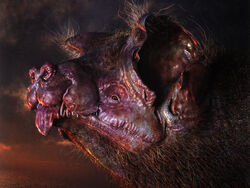
Gigapterus tropospherus, the mega-bat of the future: features of the ears and a well-developed muzzle. These organs, sensory cells mat, allow the animal to detect hot air thermals over very long distances. The head is 70 cm wide.

Gigapterus tropospherus holds a double record: the largest flying animal of all time - with a wingspan of 15 meters - and that of the first. This giant bat does not, in fact, ever set one foot on the ground.
Systematic: Mammal, chiroptere (bat) microchiroptere, neochiropteridea
Etymology: The Latin "giga" giant and "pterus" wing.
Cousin of the XXI century: Tadarida brasiliensis, or Mexican free-tailed bat.
Size: 15 meters wingspan for males, 12 meters wingspan females.
Distribution and habitat: The size of the population is very low - a thousand individuals only - but its distribution is almost worldwide, except at the poles. The species migrates to places that suit for flight currents and may travel up to 7,000 meters. However, most people are fishing the surface or "stagnant" to 5000 meters above sea level, above the tropical waters where the thermals are strong.
Morphology: The body is covered with a brown fleece more or less provided with the seasons. The oversized wings allow to glide over long distances. Robust and translucent, they are equipped with solar collectors forming dark spots. These solar panels are made of melanocytes, cells that normally pigmented skin, hair and feathers of vertebrates, and which store solar energy by day to restore it at night or when the animal is flying at very high altitude. Finally, the inner wall of the ears is covered with sensory cells hypersensitive. Derived from those used by our bat to their echolocation, these cells allow the animal to detect the warm air currents over long distances.
Physiology: Gigapterus tropospherus has a battery remarkable physiological adaptations enabling it to fly at high altitude where oxygen is scarce. His huge lungs-they occupy 80% of the volume of the body-are highly branched and consist of many cells, thus optimizing gas exchange. The bones are hollow and filled bags for flight easing the skeleton, as could be observed in birds of the 21st century.
Etology: Since all birds have become land, the future bat Neochiroptere (the Gigapterus and his cousins Velocipterus), quickly leave the shadows and the night become day and take the Ecological Niche leave vacant by birds and so know a new evolutionary radiation. The Gigapterus troposherus has replaced the highly migratory birds, large birds of prey and condors. Unable to hunt on land at risk of damaging its wings, Gigapterus hunt only of flying prey such as Velocipterus acrobatus he grabs them in flight.
Reproduction: Male and female sniff, they fish together before borrowing coastal currents ancestors to mate aloft. The female gives birth at high altitude. She gives birth to a single abortion that terminates its development into a pocket like the one possessed marsupials in the 21st century. Then he took the plunge. Parents ensure that their offspring flies quickly. Parents and children then move in formation, one above the other, so that the lean-flying can be eventually caught in flight in case of awkward flapping.
